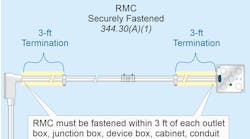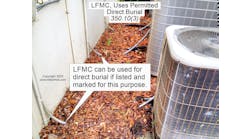Courtesy of www.MikeHolt.com
Q. What are the requirements for installing RMC couplings and connectors?
See answer below.
A. The requirements for installing RMC couplings and connectors are found in Sec. 344.42.
(A) Installation. Threadless couplings and connectors must be made up tight to maintain an effective ground-fault current path to safely conduct fault current in accordance with Sec. 250.4(A)(5), Sec. 250.96(A), and Sec. 300.10.
Author's comment: Loose locknuts have been found to burn clear before a fault was cleared because loose connections increase the impedance of the ground-fault current path.
If buried in masonry or concrete, threadless fittings must be of the concrete-tight type. If installed in wet locations, fittings must be listed for use in wet locations and prevent moisture or water from entering or accumulating within the enclosure in accordance with Sec. 314.15.
(B) Running Threads. Running threads are not permitted for the connection of couplings, but they are permitted at other locations.
These materials are provided to us by Mike Holt Enterprises in Leesburg, Fla. To view Code training materials offered by this company, visit www.mikeholt.com/code.





